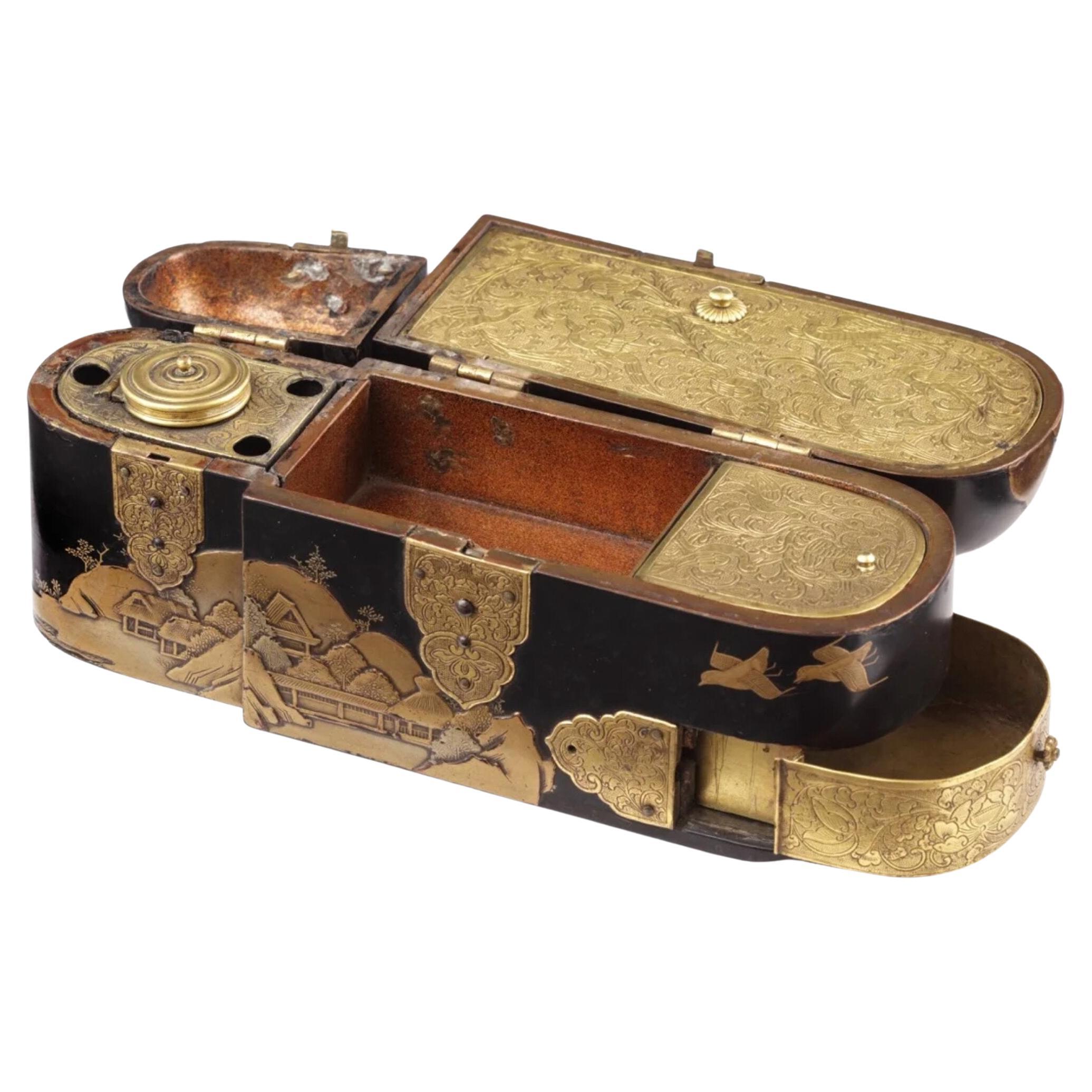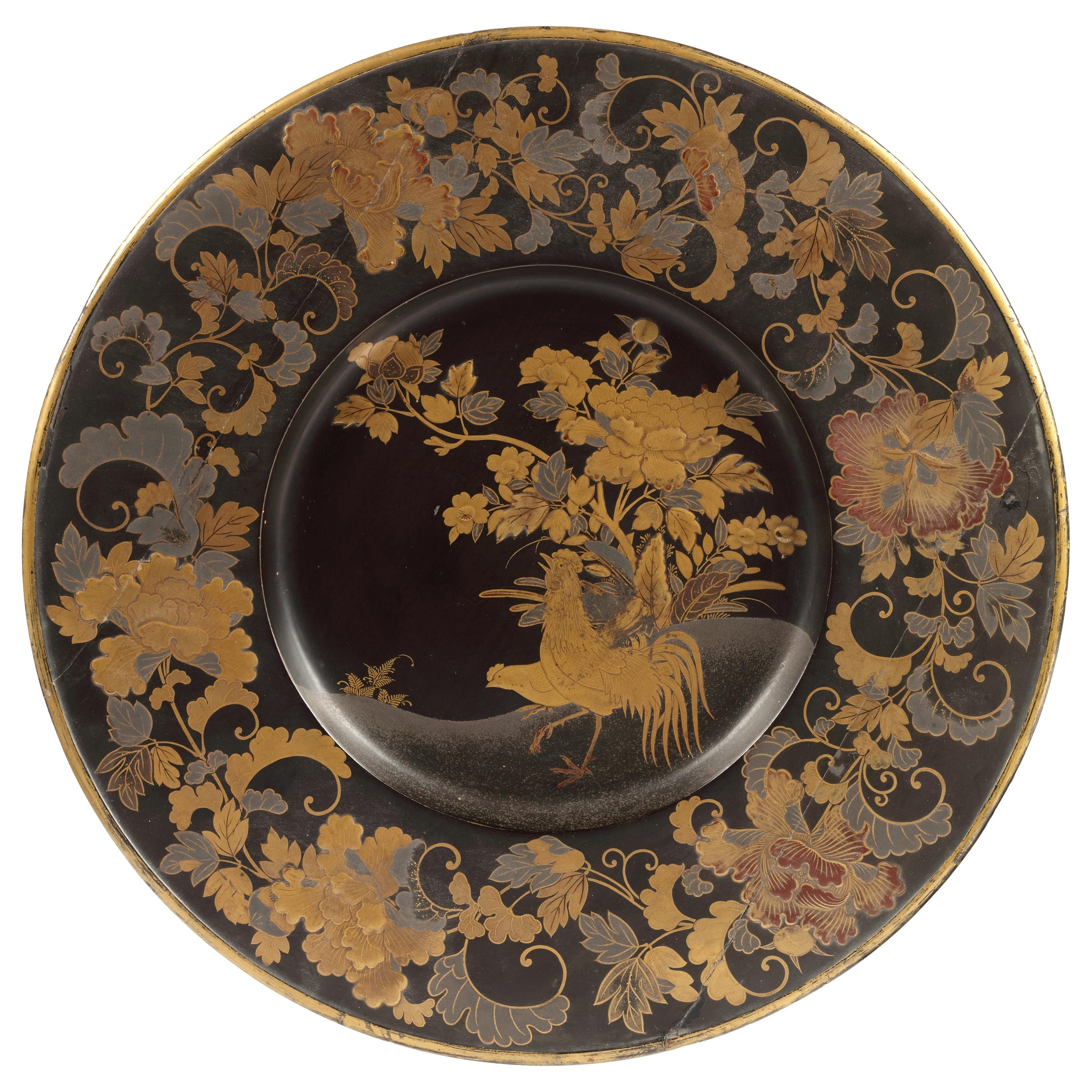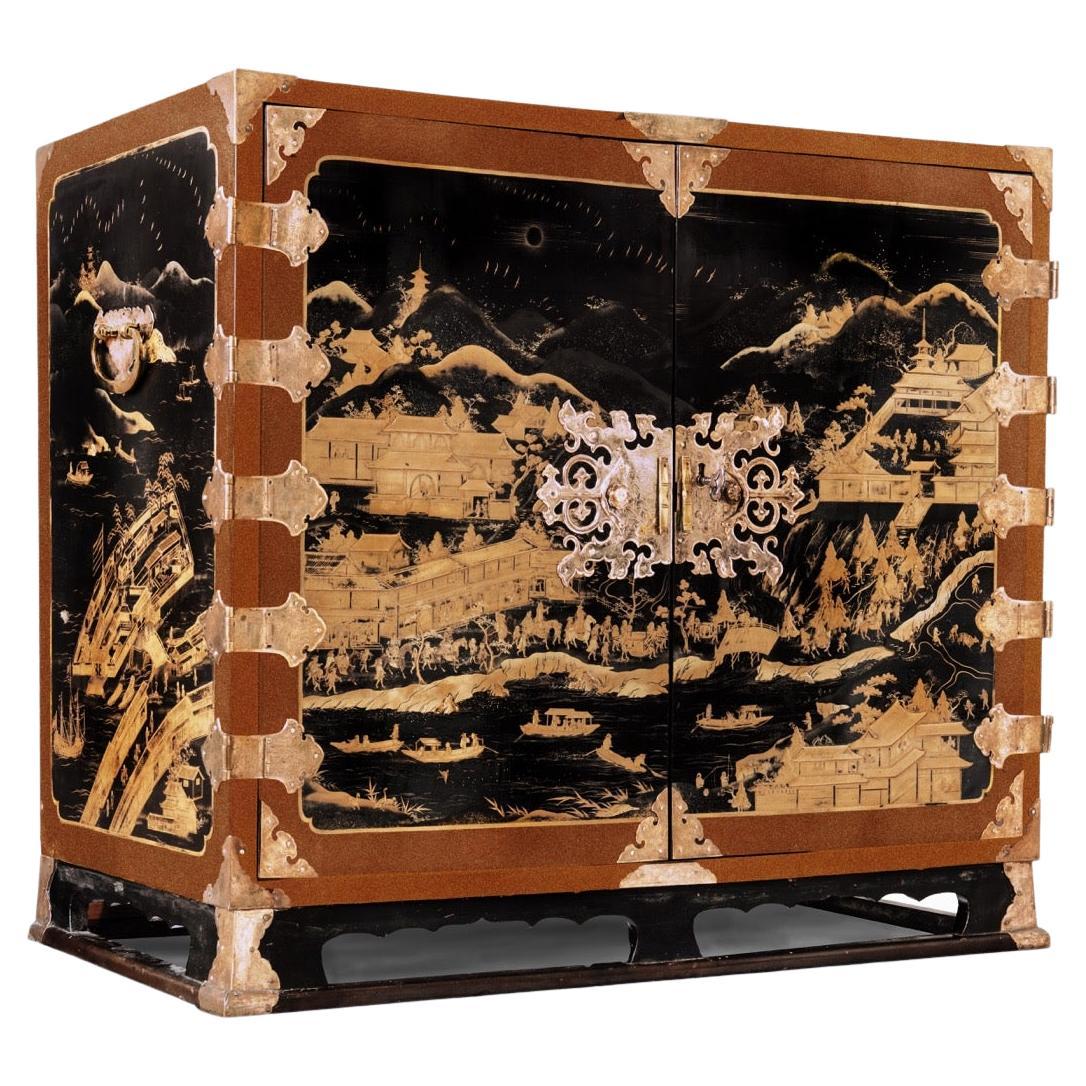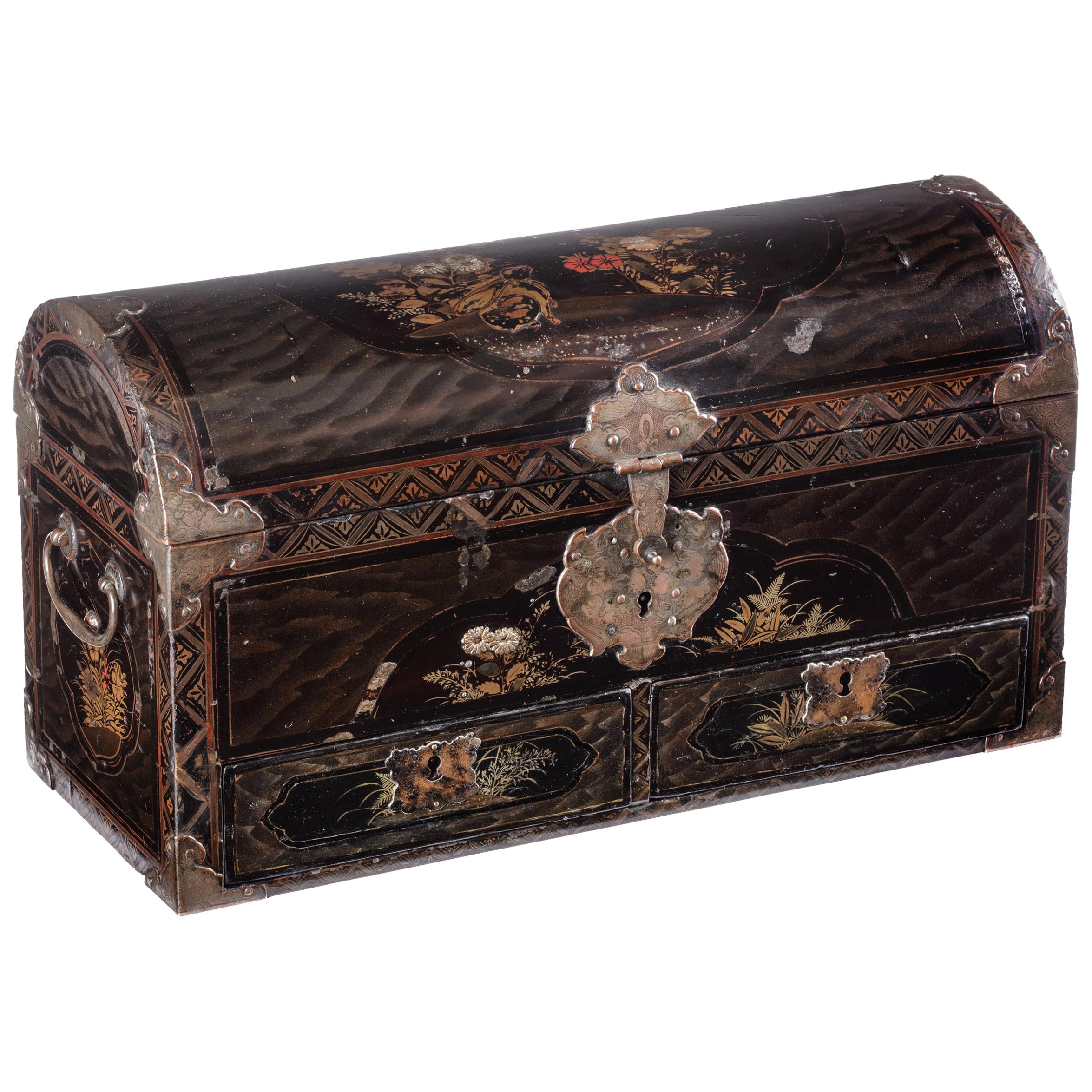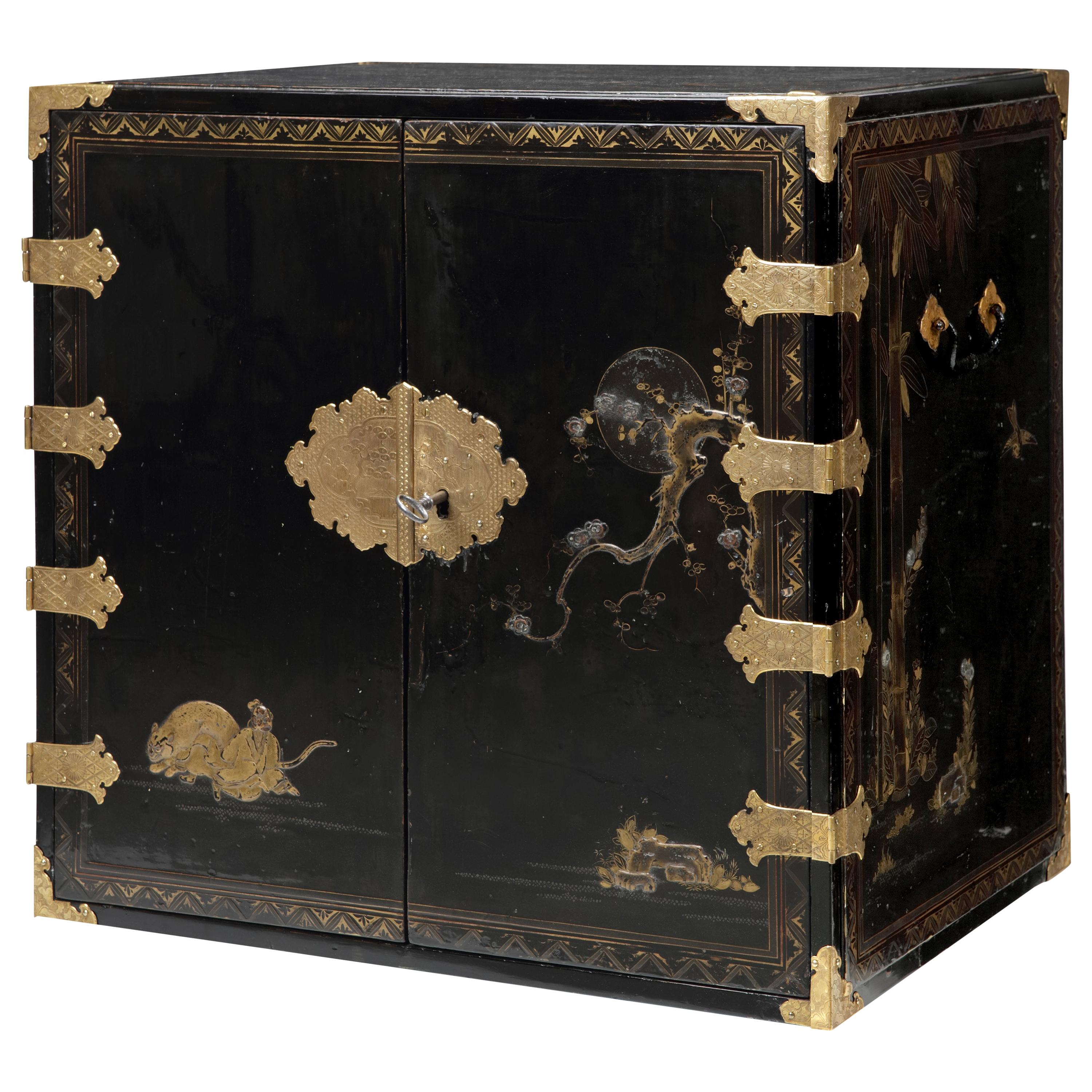Items Similar to Extremely Fine and Rare 17th-Century Japanese Export Lacquer and Inlaid Cabinet
Want more images or videos?
Request additional images or videos from the seller
1 of 10
Extremely Fine and Rare 17th-Century Japanese Export Lacquer and Inlaid Cabinet
About the Item
An extremely fine and important Japanese lacquer cabinet with gilt-copper mounts for the European market
Edo period, late 17th century
The pictorial style decorated rectangular cabinet in black lacquer decorated in gold, silver, red and brown very fine taka-maki-e, with inlays in gold, silver, mother-of-pearl, and coral. The left door shows a tapering, high-relief taka-maki-e vase upon a tray with cloud-like patterns. Irises, peonies, and chrysanthemums in polished silver, are amongst the blooming flowers which draw admirers out of their thatched huts on the right-hand door. The doors open to reveal ten various-sized drawers decorated in gold and red lacquer on a black ground, the interior of the drawers in nashiji.
W. 91 x D. 52 x H. 70.5 cm
Provenance:
Property of a Gentleman, the Netherlands
This cabinet belongs to the so-called ‘fine group’ of export lacquer created for the VOC or private traders during the height of Japanese lacquer’s popularity in Europe.
Although the exact meaning of the image remains unclear, it is evident that the arrangement of flowers is in the Rikka style of Ikebana. Rikka arrangements were originally intended as Buddhist offerings, which explains the reverse swastika displayed in the middle of the slender offering vase.
A pair of very similar cabinets, possibly by the same workshop, is in the collection of the Palazzo Reale in Torino, and another Japanese export cabinet showing strong compositional similarities is in Drayton House, Northamptonshire (Oliver Impey & Christiaan Jo¨rg, Japanese Export Lacquer 1580-1850, Hotei Publishing 2005, p. 133).
?Literature:
Oliver Impey & Christiaan Jo¨rg, Japanese Export Lacquer 1580-1850, Hotei Publishing 2005, p. 133 (ill.).
- Dimensions:Height: 27.76 in (70.5 cm)Width: 35.83 in (91 cm)Depth: 20.48 in (52 cm)
- Materials and Techniques:
- Place of Origin:
- Period:Late 17th Century
- Date of Manufacture:1680-1690
- Condition:Wear consistent with age and use.
- Seller Location:Amsterdam, NL
- Reference Number:1stDibs: LU5458229649422
About the Seller
5.0
Vetted Seller
These experienced sellers undergo a comprehensive evaluation by our team of in-house experts.
Established in 1985
1stDibs seller since 2020
19 sales on 1stDibs
Typical response time: 3 hours
- ShippingRetrieving quote...Ships From: Amsterdam, Netherlands
- Return PolicyA return for this item may be initiated within 7 days of delivery.
More From This SellerView All
- Rare 17th Century Japanese Export Lacquer Medical Instrument BoxLocated in Amsterdam, NLA rare Japanese export lacquer medical instrument box Edo-period, 1650-1700 L. 19 x W. 6 x H. 8.5 cm This unconventionally shaped lacquer b...Category
Antique 17th Century Japanese Edo Lacquer
MaterialsGold
- Fine 17th Century Japanese Export Black and Gold Lacquered Pictorial-Style DishLocated in Amsterdam, NLA fine Japanese export black and gold lacquered pictorial-style dish Nagasaki or Kyoto, 1680-1720 The dish with wide flat rim of Keaki wood (Zelkova species) in black lacquer with...Category
Antique 17th Century Japanese Edo Lacquer
MaterialsGold
- 17th Century Japanese Export Lacquer Cabinet with Depiction the Dutch TradepostLocated in Amsterdam, NLA highly important Japanese export lacquer cabinet with depiction of the Dutch East India Company tradepost Deshima and the annual Dutch delegation on its way to the Shogun in Edo Edo period, circa 1660-1680 H. 88 x W. 100.5 x D. 54 cm This cabinet includes a later European japanned stand, but also a modern powder-coated steel frame. The latter can be designed and added to your specific needs. The sides and front of the rectangular two-door cabinet are embellished in gold and silver hiramaki-e and takamaki-e on a black roiro lacquer ground with a continuous design. The two doors depict a long procession of numerous figures travelling on foot and horseback along buildings and a pagoda into a mountainous landscape. This is the annual court journey, Hofreis, of the Dutch from Nagasaki to the Shogun’s court in Edo. Three horseback riders are dressed as Dutch merchants and a fourth figure, probably het Opperhoofd, is seen inside a palanquin, norimon. Just about to cross the bridge, two men are carrying a cabinet like the present one. Many Japanese figures on either side of the procession are engaged in various activities; some play musical instruments on board of small boats, others are fishing; figures inside buildings are depicted playing go, and farmers are tending to their rice paddocks. The upper part of the right door shows a large mansion, probably the local daimyo’s castle, with men kneeling before a man in the central courtyard. The court journey fits in with the foreign policy of the shogunate which accorded a role to the VOC alongside China, Korea, and the Ryukyu Islands who also had to pay tribute. However, the VOC employees were traders, having low status in Japan’s social hierarchy, and they were received with less deference than were the state embassies from Korea and the Ryukyu Islands. Nevertheless, the contacts with the Dutch were a welcome source of information to the Shogun about Europe and European science and technology. The left side of the cabinet depicts, in mirror image, a rare view of the artificial fan-shaped Deshima Island, the trading post for the Dutch in Japan. The island, where the Dutch flag flies, is surrounded by small Japanese boats and an anchored three-masted fluyt (cargo ship), flying Dutch flags, with on the stern the VOC monogram. On the bottom right a busy street of Nagasaki is shown, bordered by shops and leading up to the stone bridge. On the island the trees are beautifully painted, two cows can be seen, and the flagpole, all in very fine detail. Dutchmen and enslaved Malay are visible outside the buildings and two Japanese figures, probably guards, sit in a small hut in the centre. A maximum of fifteen to twenty Dutchmen lived on the island at any time and soldiers or women were not allowed. Restrictions on Deshima were tight, and the merchants were only allowed to leave the island by special permission. The Opperhoofd had to be replaced every year, and each new Opperhoofd had to make a court journey to pay tribute, present gifts, and to obtain permission to Margaret Barclay eep on trading. In the distance, many birds fly above the hills and a four-story pagoda can be seen. The right side of the cabinet is painted with other horse riders and their retinue journeying through mountains. The pair of doors to the front open to reveal ten rectangular drawers. The drawers are decorated with scenes of birds in flight and landscapes with trees and plants. The reverse of the left door with two thatched buildings, one with a ladder, underneath a camelia tree with large blooms; the right door with a three-story pagoda nestled among trees and both doors with a flying phoenix, ho-oo bird. The cabinet, with elaborately engraved gilt copper mounts, hinges, lock plates and brass handles, is raised on an 18th-century English japanned wood stand. A pair of large cabinets...Category
Antique 17th Century Japanese Edo Lacquer
MaterialsCopper, Gold
- Fine Japanese Namban Lacquer Jewelry Casket, 17th CenturyLocated in Amsterdam, NLJapanese Namban lacquer transition-style coffer with two drawers Kyoto/Nagasaki, circa 1650 The cartouches with gilt and red decorations of leaves...Category
Antique 17th Century Japanese Edo Lacquer
MaterialsCypress
- Rare Charming 17th Century Japanese Lacquer Cabinet with Gilt-Bronze MountsLocated in Amsterdam, NLA fine Japanese pictoral style lacquer cabinet with gilt-metal mounts Kyoto, Edo period, 1670-1690 Decorated in Japanese relief lacquer work, black lacquer ground decorated...Category
Antique Late 17th Century Japanese Furniture
MaterialsBronze
- Four magnificent 17th-century Japanese export gold lacquer Liquor or Gin bottlesLocated in Amsterdam, NLA set of four extremely rare and important pictorial-style Japanese export lacquer bottles Edo-period, circa 1650-1680 H. 15.5 x W. 6.9 x B. 7.6 cm (each) The bottles with red cop...Category
Antique Mid-17th Century Japanese Edo Lacquer
MaterialsCopper, Gold, Silver
You May Also Like
- 17th Century Japanese Negoro Style Lacquered StandLocated in Fukuoka, JPA Rare Negoro Lacquer Buddhist Stand This rare and historic Negoro lacquer Buddhist stand is a beautiful example of Japanese craftsmanship. It is made of wood with Negoro-style lacq...Category
Antique 17th Century Japanese Lacquer
MaterialsWood, Lacquer
- Japanese Lacquer and Cinnabar "Samurai" Cabinet, Inaba Family, Edo PeriodLocated in Troy, NYExceptionally large and rare lacquer cabinet. According to the heraldry, visible on the headgear in one of the panels, it was made for the Inaba family, a high ranking Daimyo family,...Category
Antique Late 19th Century Japanese Edo Lacquer
MaterialsWood
- Japanese 19th Century Miniature Lacquer Chest with WaterfallLocated in Hudson, NYJapanese 19th century miniature lacquer chest with waterfall. Late Edo to early Meiji period lacquer chest (mid to late 19th century) with two characters on the front reading Nuno an...Category
Antique Late 19th Century Japanese Lacquer
MaterialsGold, Silver, Bronze
- Japanese Lacquered Basin with Ear-Shaped Handles 'Mimidarai', 17th CenturyLocated in Milano, ITWooden basin with ear-shaped handles decorated with hiramaki-e lacquer and gold and silver kirigane on a nashi-ji ground. The large and thick antique woo...Category
Antique 17th Century Japanese Lacquer
MaterialsWood
- Japanese Black Lacquer Tana (Tiered Tea Cabinet) with Gold Family CrestsLocated in Hudson, NYJapanese Black Lacquer Tana (Tiered Tea Cabinet) with Gold Family Crests, Covered with gold family crest designs. Made of lacquered wood and bronze mounts. Interior has wonderful r...Category
Antique Early 19th Century Japanese Edo Cabinets
MaterialsBronze, Gold Leaf
- Japanese Lacquer Incense Box, Kogo, Momoyama or Edo Period, 16th/17th CenturyLocated in Austin, TXA wonderful Japanese lacquer incense box, kogo, with a design of sparrows in flight, late Momoyama or early Edo Period, circa 1600, Japan. The small box, called a kogo, was used t...Category
Antique Early 17th Century Japanese Edo Lacquer
MaterialsGold, Pewter
Recently Viewed
View AllMore Ways To Browse
Lacquered Brass
Antique And Fine Art
Lacquer Lacquer Cabinet
Pair Lacquer
Pair Of Lacquer
Black Lacquer Brass Furniture
Black Lacquer Brass
Black Lacquer And Brass
Black Lacquered And Brass
Inlaid Cabinet
Lacquered Cabinet Wood
Brown Lacquered Cabinet
Antique Inlaid Cabinet
Black Lacquer Cabinet
Extremely Fine
Pair Black Lacquer
Lacquered Cabinets
Japanes Rare
